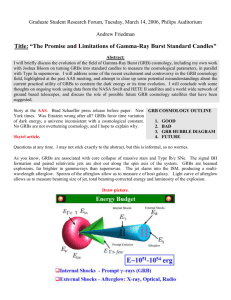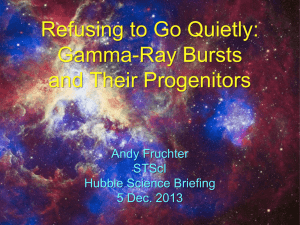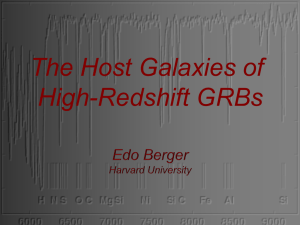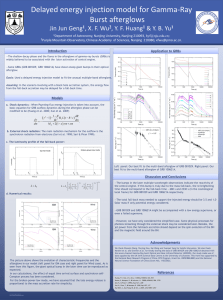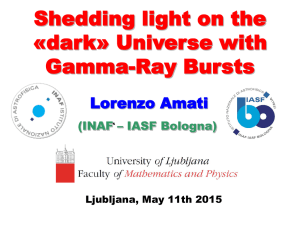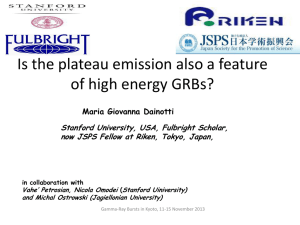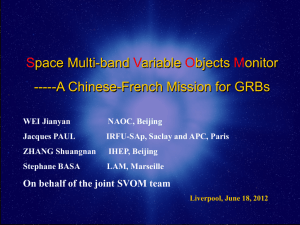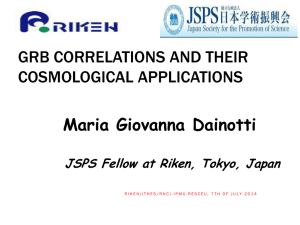Measuring Cosmological Parameters with GRBs: Status and
advertisement
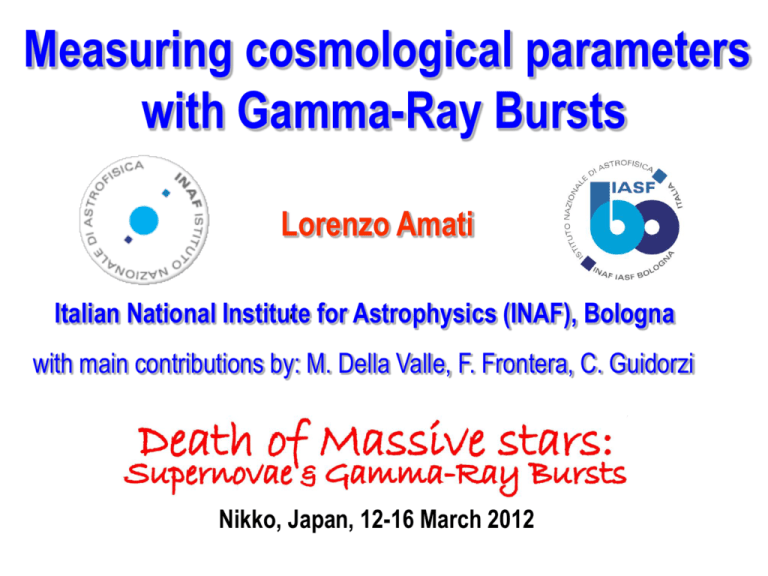
Measuring cosmological parameters with Gamma-Ray Bursts Lorenzo Amati Italian National Institute for Astrophysics (INAF), Bologna with main contributions by: M. Della Valle, F. Frontera, C. Guidorzi Nikko, Japan, 12-16 March 2012 Why looking for more cosmological probes ? different distribution in redshift -> different sensitivity to different cosmological parameters DL 1 z c H o | k | 0.5 S | k | 0.5 k 1 z z 0 2 M 1 z ' 3 0.5 dz ' Guy et al. 2010 Astier et al. 2006 Recent results from SNLS (231 SNe Ia at 0.15 < z < 1.1, Guy et al. 2010) compared to those of Astier et al. 2006 (44 low redshift SNe along with the 71 SNe from the SNLS first year sample) Each cosmological probe is characterized by possible systematics e.g SN Ia: different explosion mechanism and progenitor systems ? May depend on z ? light curve shape correction for the luminosity normalisation may depend on z signatures of evolution in the colours correction for dust extinction anomalous luminosity-color relation contaminations of the Hubble Diagram by no-standard SNe-Ia and/or bright SNe-Ibc (e.g. HNe) Are GRB standard candles ? all GRBs with measured redshift (~250, including a few short GRBs) lie at cosmological distances (z = 0.033 – 9.4) (except for the peculiar GRB980425, z=0.0085) isotropic luminosities and radiated energy are huge and span several orders of magnitude: GRB are not standard candles (unfortunately) Jakobsson, 2009 Amati, 2009 jet angles, derived from break time of optical afterglow light curve by assuming standard scenario, are of the order of few degrees the collimation-corrected radiated energy spans the range ~5x1049 – 5x1052 erg-> more clustered but still not standard Ghirlanda et al., 2004 GRB have huge luminosity, a redshift distribution extending far beyond SN Ia high energy emission -> no extinction problems Ghirlanda et al, 2006 GRB have huge luminosity, a redshift distribution extending far beyond SN Ia high energy emission -> no extinction problems potentially powerful cosmological sources but need to investigate their properties to find ways to standardize them (if possible) Ghirlanda et al, 2006 The Ep,i – Eiso correlation GRB spectra typically described by the empirical Band function with parameters a= low-energy index, b= high-energy index, E0=break energy Ep = E0 x (2 + a) = observed peak energy of the nFn spectrum measured spectrum + measured redshift -> intrinsic peak enery and radiated energy Ep,i = Ep x (1 + z) 190 GRB Ep Jakobsson (2009) ~260 GRBs with measured redshift, about 50% have measured spectra both Ep, i and Eiso span several orders of magnitude and a distribution which can be described by a Gaussian plus a low – energy tail (“intrinsic” XRFs and sub-energetic events) 95 GRBs, sample of Amati, Frontera & Guidorzi, A&A (2009) Amati et al. (A&A 2002): significant correlation between Ep,i and Eiso found based on a small sample of BeppoSAX GRBs with known redshift BeppoSAX GRBs Ep,i – Eiso correlation for GRBs with known redshift confirmed and extended by measurements of ALL other GRB detectors with spectral capabilities 130 long GRBs as of Sept. 2011 BeppoSAX GRBs Ep,i of Swift GRBs measured by Konus-WIND, Suzaku/WAM, Fermi/GBM and BAT (only when Ep inside or close to 15-150 keV and values provided by the Swift/BAT team (GCNs or Sakamoto et al. 2008). Swift GRBs strong correlation but significant dispersion of the data around the best-fit powerlaw; the distribution of the residuals can be fit with a Gaussian with s(logEp,i) ~ 0.2 the “extra-statistical scatter” of the data can be quantified by performing a fit whith a max likelihood method (D’Agostini 2005) which accounts for sample variance and the uncertainties on both X and Y quantities with this method Amati et al. (2008, 2009) found an extrinsic scatter sint(logEp,i) ~ 0.18 and index and normalization t ~0.5 and ~100, respectively “Standardizing” GRB with Ep,i-brightness correlations 2004: evidence that by substituting Eiso with the collimation corrected energy Eg the logarithmic dispersion of the correlation decreases significantly and is low enough to allow its use to standardize GRB (Ghirlanda et al., Dai et al, and many) BUT… the Ep-Eg correlation is model dependent: slope depends on the assumptions on the circum-burst environment density profile (ISM or wind) addition of a third observable introduces further uncertainties (difficulties in measuring t_break, chromatic breaks, model assumptions, subjective choice of the energy band in which compute T0.45, inhomogeneity on z of T0.45) and substantially reduces the number of GRB that can be used (e.g., #Ep,i – Eg ~ ¼ #Ep,i – Eiso ) ISM Nava et al.. , A&A, 2005: ISM (left) and WIND (right) WIND lack of jet breaks in several Swift X-ray afterglow light curves, in some cases, evidence of achromatic break challenging evidences for Jet interpretation of break in afterglow light curves or due to present inadequate sampling of optical light curves w/r to X-ray ones and to lack of satisfactory modeling of jets ? Amati et al. (2008): let’s make a step backward and focus on the Ep,i – Eiso correlation Eiso<->Liso Ep,i – Liso 04 tb,opt + jet model Ep,i – Eg “Ghirlanda” 04 Ep,i – Eiso “Amati” 02 tb,opt Ep,i – Eiso-tb “Liang-Zhang” 05 Eiso<->Lp,iso Ep,i – Lp,iso “Yonetoku”04 = T0.45 Ep,i – Lp,iso-T0.45 “Firmani” 06 Amati et al. (2008): let’s make a step backward and focus on the Ep,i – Eiso correlation Eiso<->Liso Ep,i – Liso 04 tb,opt + jet model Ep,i – Eg “Ghirlanda” 04 Ep,i – Eiso “Amati” 02 tb,opt Ep,i – Eiso-tb “Liang-Zhang” 05 Eiso<->Lp,iso Ep,i – Lp,iso “Yonetoku”04 = T0.45 Ep,i – Lp,iso-T0.45 “Firmani” 06 does the extrinsic scatter of the Ep,i-Eiso correlation vary with the cosmological parameters used to compute Eiso ? Dl = Dl (z , H0 , M , ,…) 70 GRB Amati et al. 2008 a fraction of the extrinsic scatter of the Ep,i-Eiso correlation is indeed due to the cosmological parameters used to compute Eiso Evidence, independent on SN Ia or other cosmological probes, that, if we are in a flat CDM universe , M is lower than 1 Simple PL fit Amati et al. 2008 Amati et al. 2008 By using a maximum likelihood method the extrinsic scatter can be parametrized and quantified (e.g., Reichart 2001, D’Agostini 2005) M can be constrained to 0.04-0.43 (68%) and 0.02-0.71 (90%) for a flat CDM universe (M = 1 excluded at 99.9% c.l.) significant constraints on both M and expected from sample enrichment 70 (real) GRBs Amati et al. 2008 70 (real) + 150 (sim.) GRBs analysis of the most updated sample of 137 GRBs shows significant improvements w/r to the sample of 70 GRBs of Amati et al. (2008) this evidence supports the reliability and perspectives of the use of the Ep,i – Eiso correlation for the estimate of cosmological parameters m (flat universe) 68% 90% 70 GRBs (Amati+ 08) 0.04 – 0.43 0.02 – 0.71 137 GRBs (Amati+ 12) 0.06 – 0.34 0.03 – 0.54 70 GRBs 114GRBs GRBs 137 GRB the simulatenous operation of Swift, Fermi/GBM, Konus-WIND is allowing an increase of the useful sample (z + Ep) at a rate of 15-20 GRB/year, providing an increasing accuracy in the estimate of cosmological parameters future GRB experiments (e.g., SVOM) and more investigations (physics, methods, calibration) will improve the significance and reliability of the results and allow to go beyond SN Ia cosmology (e.g. investigation of dark energy) 300 GRB 300 GRB Adapted from Amati+ 12 and Ghirlanda+ 2007 Conclusions and perspectives Given their huge radiated energies and redshift distribution extending from ~ 0.1 up to > 9, GRBs are potentially a very powerful cosmological probe, complementary to other probes (e.g., SN Ia, clusters, BAO) The Ep,i – Eiso correlation is one of the most robust (no firm evidence of significant selection / instrumental effects) and intriguing properties of GRBs and a promising tool for cosmological parameters Analysis in the last years (>2008) provide already evidence, independent on , e.g., SN Ia, that if we live in a flat CDM universe, m is < 1 at >99.9% c.l. (c2 minimizes at m ~ 0.25, consistent with “standard” cosmology) the simulatenous operation of Swift, Fermi/GBM, Konus-WIND is allowing an increase of the useful sample (z + Ep) at a rate of 15-20 GRB/year, providing an increasing accuracy in the estimate of cosmological parameters future GRB experiments (e.g., SVOM) and more investigations (physics, methods, calibration) will allow to go beyond SN Ia cosm. (e.g.,dark energy EOS) Backup slides Reliability of the Ep,i – Eiso correlation different GRB detectors are characterized by different detection and spectroscopy sensitivity as a function of GRB intensity and spectrum this may introduce relevant selection effects / biases in the observed Ep,i – Eiso and other correlations: hot debate within GRB community Band 2008 Ghirlanda et al. 2008 ? OK Amati, Frontera & Guidorzi (2009): the normalization of the correlation varies only marginally using GRBs measured by individual instruments with different sensitivities and energy bands Amati , Frontera & Guidorzi 2009 Up to date (Sept. 2011) Ep,i – Eiso plane: 131 long GRBs, 4 XRFs, 13 short GRBs method: unknown redshift -> convert the Ep,i – Eiso correlation into an Ep,obs – Fluence correlation Intrinsic (cosm. Rest-frame) plane 2s GRBs WITH redshift (130) Observer’s plane 3s 2s GRBs WITHOUT redshift (thousands) Amati, Dichiara et al. (2011, in prep.): consider fluences and spectra from the Goldstein et al. (2010) BATSE complete spectral catalog (on line data) considered long (777) and short (89) GRBs with fit with the Band-law and uncertainties on Ep and fluence < 40% LONG LONG SHORT most long GRBs are potentially consistent with the Ep.i – Eiso correlation, most short GRBs are not ALL long GRBs with 20% uncertainty on Ep and fluence (525) are potentially consistent with the correlation LONG, 40% unc. LONG, 20% unc. the Ep,i– Liso correlation holds also within a good fraction of GRBs (Liang et al.2004, Firmani et al. 2008, Frontera et al. 2009, Ghirlanda et al. 2009): robust evidence for a physical origin and clues to explanation Liang et al., ApJ, 2004 Frontera et al. 2012 (ApJ,subm.) selection effects in the process leading to the redshift estimate are also likely to play a relevant role (e.g., Coward 2008) Swift: reduction of selection effects in redshift -> Swift GRBs expected to provide a robust test of the Ep,i – Eiso correlation Ep,i of Swift GRBs measured by Konus-WIND, Suzaku/WAM, Fermi/GBM and BAT (only when Ep inside or close to 15-150 keV and values provided by the Swift/BAT team (GCNs or Sakamoto et al. 2008):Swift GRBs are consistent with the Ep,i – Eiso correlation Red points = Swift GRBs Slope ~ 0.5 s (logEp,i) ~ 0.2 Gaussian distribution of data scatter definite evidence that short GRBs DO NOT follow the Ep.i – Eiso correlation: a tool to distinguish between short and long events and to get clues on their different nature (e.g., Amati 2006, Piranomonte et al. 2008, Ghirlanda et al. 2009) the only long GRB outlier to the correlation is the peculiar GRB980425 (very low redshift z = 0.0085, sub-energetic, inconsistent with most other GRB properties) GRB 980425 What can be obtained with 150 GRB with known z and Ep and complementarity with other probes (SN Ia, CMB) complementary to SN Ia: extension to much higher z even when considering the future sample of SNAP (z < 1.7), cross check of results with different probes Ghirlanda, Ghisellini et al. 2005, 2006,2007 Method (e.g., Ghirlanda et al, Firmani et al., Dai et al., Zhang et al.): Ep,i = Ep,obs x (1 + z) , tb,i = tb / /1 + z) Dl = Dl (z , H0 , M , ,…) fit the correlation and construct an Hubble diagram for each set of cosmological parameters -> derive c.l. contours based on chi-square Calibrating the Ep,i – Eiso correlation with SN Ia several authors (e.g., Kodama et al., 2008; Liang et al., 2008, Li et al. 2008, Tsutsui et al. 2009, Capozziello & Izzo 2010) calibrated the correlation at z < 1.7 by using the luminosity distance – redshift relation derived from SN Ia The aim is to extend the SN Ia Hubble diagram up to redshift where the luminosity distance is more sensitive to dark energy properties and evolution but with this method GRB are no more an independent cosmological probe the quest for high-z GRB for both cosmological parameters and SFR evolution studies it is of fundamental importance to increase the detection rate of high-z GRBs Swift recently changed the BAT trigger threshold to this purpouse the detection rate can be increased by lowering the low energy bound of the GRB detector trigger energy band adapted from Salvaterra et al. 2008 The future: what is needed ? increase the number of z estimates, reduce selection effects and optimize coverage of the fluence-Ep plane in the sample of GRBs with known redshift more accurate estimates of Ep,i by means of sensitive spectroscopy of GRB prompt emission from a few keV (or even below) and up to at least ~1 MeV Swift is doing greatly the first job but cannot provide a high number of firm Ep estimates, due to BAT ‘narrow’ energy band (sensitive spectral analysis only from 15 up to ~200 keV) in last years, Ep estimates for some Swift GRBs from Konus (from 15 keV to several MeV) and, to minor extent, RHESSI and SUZAKU NARROW BAND BROAD BAND present and near future: main contribution expected from joint Fermi + Swift measurements Up to 2009: ~290 Fermi/GBM GRBs, Ep estimates for ~90%, ~35 simultaneously detected by Swift (~13%), 13 with Ep and z estimates (~10% of Swift sample) 2008 pre-Fermi : 61 Swift detections, 5 BAT Ep (8%), 15 BAT + KONUS + SUZAKU Ep estimates (25%), 20 redshift (33%), 11 with Ep and z estimates (~15% of Swift sample) Fermi provides a dramatic increase in Ep estimates (as expected), but a only small fraction of Fermi GRBs is detected / localized by Swift (~15%) -> low number of Fermi GRBs with Ep and z (~5%). It is difficult to improve this number: BAT FOV much narrower than Fermi/GBM; similar orbits, each satellite limited by Earth occultation but at different times, … ) Summary: 15-20 GRB/year in the Ep,i – Eiso plane In the > 2014 time frame a significant step forward expected from SVOM: spectral study of prompt emission in 5-5000 keV -> accurate estimates of Ep and reduction of systematics (through optimal continuum shape determination and measurement of the spectral evolution down to X-rays) fast and accurate localization of optical counterpart and prompt dissemination to optical telescopes -> increase in number of z estimates and reduction of selection effects optimized for detection of XRFs, short GRB, subenergetic GRB, high-z GRB substantial increase of the number of GRB with known z and Ep -> test of correlations and calibration for their cosmological use
